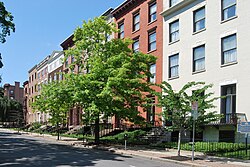|
Lafayette Park Historic District
The Lafayette Park Historic District is located in central Albany, New York, United States. It includes the park and the combination of large government buildings and small rowhouses on the neighboring streets. In 1978 it was recognized as a historic district and listed on the National Register of Historic Places (NRHP).[1] Many of its contributing properties are themselves listed on the National Register. One of them, the New York State Capitol, is a National Historic Landmark as well. Other government buildings include City Hall, the building housing Albany County government, the state's highest court and the offices of its Education Department along with the offices of the City School District of Albany. The Episcopal Diocese of Albany's cathedral is at one corner of the district. While the state capitol building has always been located on its present site, for most of the 19th century the neighborhood was best known for the townhouses on Elk Street, then one of the most desirable addresses in the city. Many politicians, including some of the state's governors and presidents Martin Van Buren[2] and Franklin D. Roosevelt,[3]: 70–74 lived there at different times. Henry James would recall the neighborhood from his childhood visits to his aunt as "vaguely portentous, like beasts of the forest not wholly exorcised."[2] Two significant technological accomplishments—the development of the first working electromagnet[4] and the construction of the first cantilevered arch bridge[2]: 6, 10–11 —also took place within it. Henry Hobson Richardson, Philip Hooker and Marcus T. Reynolds are among the architects with buildings in the district. The park that gives the district its name was not actually built until the early 20th century, after larger government buildings had begun to dominate the area. In it and the other three parks are statues commemorating George Washington and Albany natives like Civil War general Phillip Sheridan and electromagnet discoverer Joseph Henry. John Quincy Adams Ward and J. Massey Rhind are among the sculptors represented. Although the district has been affected by modern trends—most of the Elk Street houses are now offices for various organizations that lobby the state government—it has remained mostly intact. It remains a vital part of Albany's public sphere, with the parks having hosted everything from benefit sales for soldiers' medical care during the Civil War to Occupy Albany's tent encampments and protests during the 2010s. GeographyThe 36-acre (15 ha; 150,000 m2)[2]: 9 district is rectangular, extending a block to the north and south of Washington Avenue (New York State Route 5), with an irregularly shaped projection at its northeast corner. From its southeast corner, at the intersection of State and Eagle streets, it runs west along State, between the state capitol and the Empire State Plaza office complex to the south. At South Swan Street, it turns north, with the Alfred E. Smith State Office Building and other contributing properties of the adjacent Center Square/Hudson–Park Historic District on the west.[2]: 13 [5]: 13 It continues north two blocks, now bordering the Washington Avenue Corridor Historic District,[6] to the Elk Street intersection. Here it runs past Cathedral of All Saints and the back of the State Education Department building to the South Hawk Street intersection. The boundary turns north along the continuation of South Hawk and then turns east again to Columbia Street at the entrance to the top deck of a large parking garage in nearby Sheridan Hollow.[7][2]: 13 At the Eagle Street junction, it turns north to the rear lot line of a building on that side of the street, then along its east line to the rear lines of the rowhouses along Columbia Street all the way to Chapel Street. It follows that street south back to Columbia, and turns east again all the way to Lodge Street, again sharing a boundary, this time with the Downtown Albany Historic District.[2]: 13 [8]: 33–35 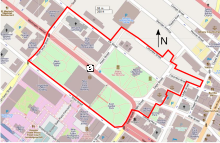 Just before reaching St. Mary's Church, at Steuben Street, the line turns west again, then south, between the New York State Court of Appeals Building and the parking lot behind it. Crossing Pine Street it jogs slightly westward, then turns south and west to Eagle Street, around the back of City Hall. From there it turns south in the middle of Eagle Street and returns to the southeast corner.[2]: 13 The terrain slopes gently eastward, toward the nearby Hudson River, becoming slightly steeper in the eastern portion of the district. On the north it drops off more abruptly into Sheridan Hollow.[9] Much of the southern portion of the district is open space. East and West Capitol parks flank that building. To its northeast, on the block between Elk, Eagle, Hawk and Washington, is one large park[2]: 13 that is actually two: Lafayette Park, owned by the state, on the west and city-owned Academy Park on the east.[10] In between them on the north side is the former Albany Academy building, now the main offices of the Albany City School District.[11] The large government buildings around the park were, like the state capitol, built in the late 19th century. Their architectural styles vary from the capitol's mix of Second Empire and French Renaissance Revival[12]: 2 to the Classical Revival stylings of the Court of Appeals[13]: 3 and Education Department building.[14]: 3 The cathedral adds some Gothic Revival to the mix.[15] The residential areas in the north primarily have two-story brick townhouses dating to the late 19th and early 20th centuries. There are 35 buildings in the district; all but three are contributing properties[2]: 2 HistoryThe district has an early period corresponding roughly to the 19th century, in which it was noted for the residences of socially prominent residents and politicians. After the completion of the current capitol building at century's end, it began to be dominated by large government buildings, with the open space, including the park that gives the district its name, coming into place in the early decades of the new century.[2]: 8 1809–1899: Elk Street and residences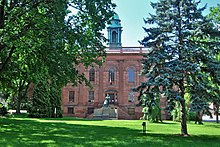 The neighborhood has been home to the centers of power since it was established. In 1809, 12 years after Albany was permanently designated New York's state capital at the end of the 18th century,[16] the first state capitol building in the city was erected on a site adjacent to the location of the current building.[17] The city government used the building as well for meetings and office space. Philip Hooker's original Albany Academy building, the oldest extant building in the district, was built 1815–17.[2]: 11 In the academy building, a dozen years later, one of the school's professors, Joseph Henry, conducted experiments with electricity that proved the existence of inductance and created the first functional electromagnet. For several years in the early 1830s he demonstrated the practical effects of this discovery to his classes by using a magnet to ring a bell at the end of a wire run around the room. Not only was this the prototype for the electric doorbell, it has been considered an important step on the road to the invention of the telegraph two decades later.[4] In 1832, the city government decided it needed its own city hall, and Hooker provided a domed marble Greek Revival building on the present site, which had already been designated for future development as a public square. The next year, the two acres (8,100 m2) on the east of the Academy building were formally laid out as Academy Park. It was encircled by an iron fence similar to that which Hooker had designed for nearby Capitol Park.[3] Elk and Columbia streets were the center of development, primarily residential, in the district during this era. On the former, the houses closest to the park, Nos. 2 through 7, were built between 1827 and 1833, among them some considered Albany's finest Greek Revival houses. Columbia Street, where Henry made his home at 107, was developed more modestly.[3]: 74–78 Because of its proximity to the capitol, Elk Street was often a preferred residence of the state's governors during this era, since New York did not erect its governor's mansion until later in the 19th century. William L. Marcy lived at 2 Elk Street during his first term, and Hamilton Fish made 21 Elk his home after he was elected in 1848. Daniel Barnard, a congressman and later ambassador to Germany, lived at 25 Elk Street and may have owned 1 Elk Street (since demolished). Three governors—Enos T. Throop, Washington Hunt and Horatio Seymour—rented the building from him during their tenure in office.[2]: 8 Martin van Buren, a state senator and New York's Attorney General before he became U.S. President, owned 4 Elk Street and lived there for some of the time he was not serving in the latter post. While he was, it was occupied by his son Smith Thompson and his wife, Ellen King James. Among the visitors who came to the house in the later years was Ellen's young nephew Henry. Later in his life, when he had become an accomplished novelist, he wrote that Elk Street had always seemed to him "vaguely portentous, as though beasts of the forests not fully exorcised."[2]: 8 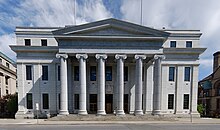 The first of the large buildings, mostly governmental edifices, that dominate the district today, the New York State Court of Appeals Building, was designed in 1835 and opened in 1842.[18] Originally "State Hall", housing a number of other state offices before the court moved in following its 1847 creation, Henry Rector's neoclassical structure used all three orders in its design. It was considered one of the finest government buildings of its era.[19] Four years later, 17 Elk Street, the grandest house yet built on that street, was sold to John V. L. Pruyn, an industrialist who later served in the state senate and U.S. House. It was expanded to the east in 1858.[3]: 74–78 After the Civil War, during which a temporary structure was set up in Academy Park as the Army Relief Bazaar to raise money for medical supplies, this change accelerated further with the beginning of construction of the new capitol. Marcus T. Reynolds, an architect who worked in the city through the 1930s, was born at 98 Columbia Street in 1869 and lived there both as a child and an old man. In 1880, Hooker's 1832 City Hall burned down. Henry Hobson Richardson, then in Albany working on the state capitol, designed the current building to replace it, and it was soon completed, in part because the budget and cost overruns did not allow for an interior to match Richardson's ornate Romanesque exterior.[3]: 70–74 In the decade after the war, Elk Street continued to be a residential neighborhood. Reflecting the Gilded Age, most of those who made their homes there were not politicians but some of the city's newly wealthy industrialists.[2]: 10 The park was neglected during this time—Huybertie Pruyn, who lived in the area as a child during the 1870s and '80s, recalls it as a "wretchedly kept place". It had only one light in the center, was locked at 10 p.m. every night, and even so children were warned not to go into it after dark.[3]: 70–74 The Rev. William Croswell Doane had been appointed bishop of the Episcopal Diocese of Albany in 1867. He lived at 29 Elk Street, and presided over the construction of Cathedral of All Saints, completed in 1888. The young architect Robert W. Gibson won the commission over Richardson with his Gothic Revival design. Doane's original plan was for the block on which the cathedral was located to be an entire campus with a school, hospital and convent, a "mother church" for the diocese, similar to some Anglican cathedrals in England. He was unable to persuade the church's trustees to spend the additional money, which would have an effect on the building later.[20]: 7–8 The same year, the thousand-foot (300 m) Hawk Street Viaduct was built, connecting the neighborhoods north of Sheridan Hollow, now home to many of the workers in the industrialized city, with the Lafayette Park area. Since dismantled, it is believed to have been the first cantilevered arch bridge in the world, designed by former state engineer Elnathan Sweet. A segment of the iron railing and its south abutment remain, as contributing properties.[2]: 6, 10–11 Elk Street remained an address known for its high style. In 1897, newly elected Lieutenant Governor Timothy L. Woodruff, who would serve three governors in that position, moved into 5 Elk Street. Albany society took immediate notice of his penchant for the latest clothing, his fine horses, and his English coachman, who had most recently worked for Lilly Langtry, Prince Edward's mistress.[3]: 74–78 In 1899, the new state capitol was finally finished. With government so firmly established in the area, some of the old houses nearby began to be adapted into office space for institutions that desired the proximity to the state's elected officials, or subdivided into smaller living spaces. A fire insurers' organization converted 1–2 Columbia Place, including one of the buildings that had served as sculptor Erastus Dow Palmer's studio in the middle of the century,[3]: 70–74 into its offices. Similarly, 105–107 Columbia Street became an apartment building.[2]: 11 1900–present: New Capitol, government buildings and parks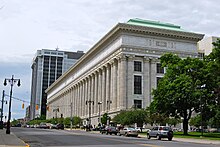 The early 20th century significantly transformed the district. First, two more large government buildings were added. In 1906 Andrew Sloan Draper, first commissioner of the state's State Education Department (SED), wanted to move his agency into space of its own near the capitol along with the state library and museum. He considered the block on which Cathedral of All Saints stood to be the ideal location; however, the cathedral still owned some of the land and his approaches to the Doane, who had not abandoned his mother church plan, led to animosity between the two. While the bishop was traveling overseas, Draper used his political influence to have the state buy all the remaining land on the block.[3]: 79 Doane, forced to abandon his longtime plan, succeeded in getting the legislature to limit the SED building to two stories, but Draper retaliated by making sure that those two stories, on Henry Hornbostel's colonnaded marble Beaux-Arts structure were as tall as possible, blocking the cathedral off from the rest of the city.[21]: 8 While it was being built, the district would be home for two years to another resident later to become prominent, future president Franklin Delano Roosevelt. He lived in 4 Elk Street from 1910 to 1912 while serving as a state senator.[3]: 76 Other houses nearby, and on Columbia, were being renovated, usually by Marcus T. Reynolds.[3]: 74–78 In 1912, the Education Department building was completed, followed four years later by Albany County's new courthouse and office building next to the Court of Appeals.[2]: 11 During the time the district was preparing to receive its distinguishing feature. Starting in 1908, the block between Academy Park and Hawk Street was cleared to create Lafayette Park, named for the Marquis de Lafayette, who had stayed in Albany during 1778 and visited the city in the 1820s.[22] In the process more than 30 houses were demolished, including those of Palmer and writer Leonard Kip.[2]: 11 With the space opening up, more public statuary was erected. Daniel Chester French arranged for John Quincy Adams Ward's memorial sculpture to Union Army General Phillip Sheridan, an Albany native, to be posthumously placed on a pedestal east of the capitol designed by Lincoln Memorial architect Henry Bacon.[3]: 68 In 1925, a J. Massey Rhind statue of another Albany military man, Revolutionary War General Phillip Schuyler, went up in front of City Hall. It was followed two years later by one of Joseph Henry, sculpted by John Flanagan, in front of the Albany Academy.[3]: 71–73  West Capitol Park was expanded threefold from a modest plan submitted by the sons of Frederick Law Olmsted in 1898. In keeping with the ideals of the contemporary City Beautiful movement, it was reimagined as a "court of honor", surrounded by the Capitol, SED building and the newer Alfred E. Smith Building, towering over the older ones at the park's west side. Ideas by former state architects Franklin B. Ware and Lewis Pilcher were also incorporated. When it opened in 1930 it framed the capitol's west facade with a tree-lined entrance mall. A replica of Jean-Antoine Houdon's statue of George Washington, displayed in the rotunda of the Virginia State Capitol, was installed in the park in 1932 to commemorate the first president's bicentennial.[3]: 80 The changes in the neighborhood were reflected in its building use. In 1930, the academy moved out of the building it had outgrown; after the city bought it eventually became the offices of the Albany City School District. Reynolds, in one of his final projects, supervised the renovation of the interior, a New Deal project funded by the Public Works Administration.[3]: 70–74 The Pruyns had moved out of 17 Elk Street around 1910;[2]: 10 their house eventually became the state headquarters of the Independent Order of Odd Fellows. They were followed by most of the other socially prominent families who had called Elk home. The house at 4, where the young Henry James had visited his aunt almost a century before, likewise became home to another fraternal organization, the Moose International.[2]: 11 Through the middle of the century the district remained stable, with no significant new buildings, demolitions or other changes. That began to change in the late 1960s as urban renewal touched Albany, and the modernist towers of Empire State Plaza rose to the south, dwarfing the older government buildings in the district. Preservation efforts grew. Daniel Barnard's old house at 1 Elk Street was demolished in 1969.[2]: 8 At the corner of Elk and Eagle, activists were able to save the facades of three townhouses which were otherwise to have been demolished for another modernist building, James Stewart Polshek's New York Law Center, which they serve to screen from the street.[3]: 74–78 The following year, 1970, the Hawk Street viaduct was dismantled. Only its south abutment and a portion of its handrail were left. As Empire State Plaza neared completion in the late 1970s, the state library and museum left the SED building for larger, dedicated space of their own built within the new complex.[3]: 80 In 1986, a memorial to Albany County's dead and missing from the Vietnam War was commissioned for Lafayette Park. Sculptor Merlin Szosz produced a stele in the classical Greek mode, made of pink Brazilian granite and adorned with the names of those casualties, plus a relief of a soldier holding his fallen comrade amid Southeast Asian vegetation. It is set amid four gas lanterns shaped like lotuses and a circle of bronze benches. It was installed and dedicated in 1992.[3]: 78–79  Two decades later, the social turmoil that accompanied the Vietnam War on the home front echoed through the park anew. In October 2011, protesters inspired by Occupy Wall Street in Manhattan set up Occupy Albany, a tent encampment in the parks, to call attention to rising socioeconomic inequality during the Great Recession as their fellow activists downstate had. The state originally instituted a curfew of 11 p.m. for Lafayette Park in order to force them to leave, and police cited several of them for violating it. These plans failed when David Soares, the county district attorney, dropped the charges and city officials issued the group a permit to stay in Academy Park, which was under its jurisdiction and not the state's, in return for its cleanup efforts and limitations on its presence.[10] Occupy Albany stayed in the park for another 15 days before the city evicted it as winter came on.[23] The group continues to hold rallies and events in the parks.[24] Significant contributing propertiesSix buildings in the district are individually listed on the National Register in addition to being contributing properties to the district. They include the cathedral and all government buildings save the county courthouse. One of those government buildings, the state capitol, is further designated a National Historic Landmark. There are still others that are noteworthy within the context of the district.[2]: 2–6 National Historic Landmark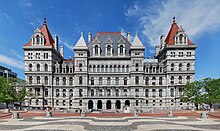
National Register of Historic Places
Others
Parks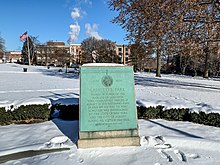
See alsoReferences
External links
|
||||||||||||||||||||||||
Portal di Ensiklopedia Dunia
